The Crucial/Micron M500 Review (960GB, 480GB, 240GB, 120GB)
by Anand Lal Shimpi on April 9, 2013 9:59 AM ESTAnandTech Storage Bench 2011
Two years ago we introduced our AnandTech Storage Bench, a suite of benchmarks that took traces of real OS/application usage and played them back in a repeatable manner. I assembled the traces myself out of frustration with the majority of what we have today in terms of SSD benchmarks.
Although the AnandTech Storage Bench tests did a good job of characterizing SSD performance, they weren't stressful enough. All of the tests performed less than 10GB of reads/writes and typically involved only 4GB of writes specifically. That's not even enough exceed the spare area on most SSDs. Most canned SSD benchmarks don't even come close to writing a single gigabyte of data, but that doesn't mean that simply writing 4GB is acceptable.
Originally I kept the benchmarks short enough that they wouldn't be a burden to run (~30 minutes) but long enough that they were representative of what a power user might do with their system.
Not too long ago I tweeted that I had created what I referred to as the Mother of All SSD Benchmarks (MOASB). Rather than only writing 4GB of data to the drive, this benchmark writes 106.32GB. It's the load you'd put on a drive after nearly two weeks of constant usage. And it takes a *long* time to run.
1) The MOASB, officially called AnandTech Storage Bench 2011 - Heavy Workload, mainly focuses on the times when your I/O activity is the highest. There is a lot of downloading and application installing that happens during the course of this test. My thinking was that it's during application installs, file copies, downloading and multitasking with all of this that you can really notice performance differences between drives.
2) I tried to cover as many bases as possible with the software I incorporated into this test. There's a lot of photo editing in Photoshop, HTML editing in Dreamweaver, web browsing, game playing/level loading (Starcraft II & WoW are both a part of the test) as well as general use stuff (application installing, virus scanning). I included a large amount of email downloading, document creation and editing as well. To top it all off I even use Visual Studio 2008 to build Chromium during the test.
The test has 2,168,893 read operations and 1,783,447 write operations. The IO breakdown is as follows:
| AnandTech Storage Bench 2011 - Heavy Workload IO Breakdown | ||||
| IO Size | % of Total | |||
| 4KB | 28% | |||
| 16KB | 10% | |||
| 32KB | 10% | |||
| 64KB | 4% | |||
Only 42% of all operations are sequential, the rest range from pseudo to fully random (with most falling in the pseudo-random category). Average queue depth is 4.625 IOs, with 59% of operations taking place in an IO queue of 1.
Many of you have asked for a better way to really characterize performance. Simply looking at IOPS doesn't really say much. As a result I'm going to be presenting Storage Bench 2011 data in a slightly different way. We'll have performance represented as Average MB/s, with higher numbers being better. At the same time I'll be reporting how long the SSD was busy while running this test. These disk busy graphs will show you exactly how much time was shaved off by using a faster drive vs. a slower one during the course of this test. Finally, I will also break out performance into reads, writes and combined. The reason I do this is to help balance out the fact that this test is unusually write intensive, which can often hide the benefits of a drive with good read performance.
There's also a new light workload for 2011. This is a far more reasonable, typical every day use case benchmark. Lots of web browsing, photo editing (but with a greater focus on photo consumption), video playback as well as some application installs and gaming. This test isn't nearly as write intensive as the MOASB but it's still multiple times more write intensive than what we were running in 2010.
As always I don't believe that these two benchmarks alone are enough to characterize the performance of a drive, but hopefully along with the rest of our tests they will help provide a better idea.
The testbed for Storage Bench 2011 has changed as well. We're now using a Sandy Bridge platform with full 6Gbps support for these tests.
AnandTech Storage Bench 2011 - Heavy Workload
We'll start out by looking at average data rate throughout our new heavy workload test:
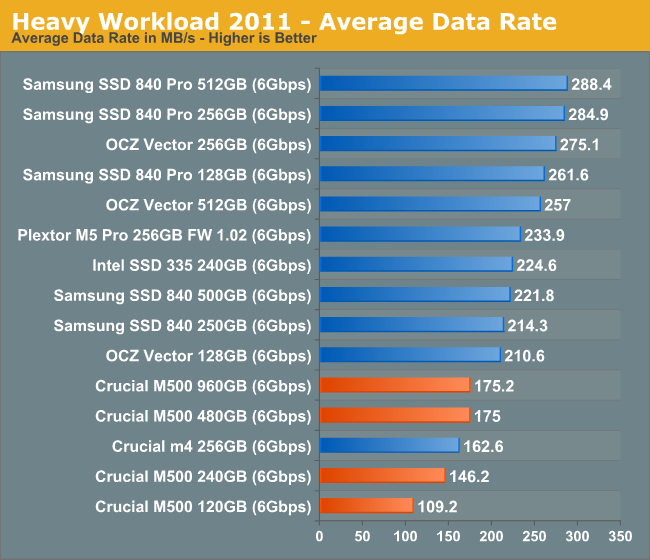
Our heavy workload from 2011 illustrates the culmination of everything we've shown thus far: the M500 can even be slower than the outgoing m4. There's no doubt in my mind that this is a result of the tradeoffs associated with moving to 128Gbit NAND die. The M500's performance is by no means bad, but it's definitely below what we've come to expect from Intel and Samsung flagships.
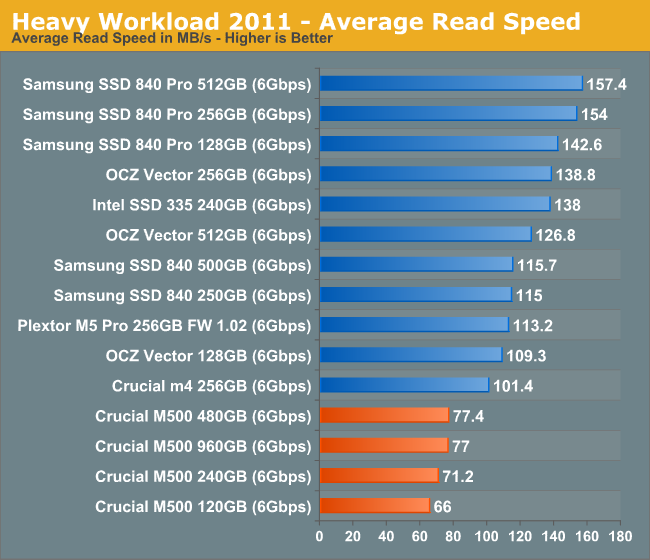
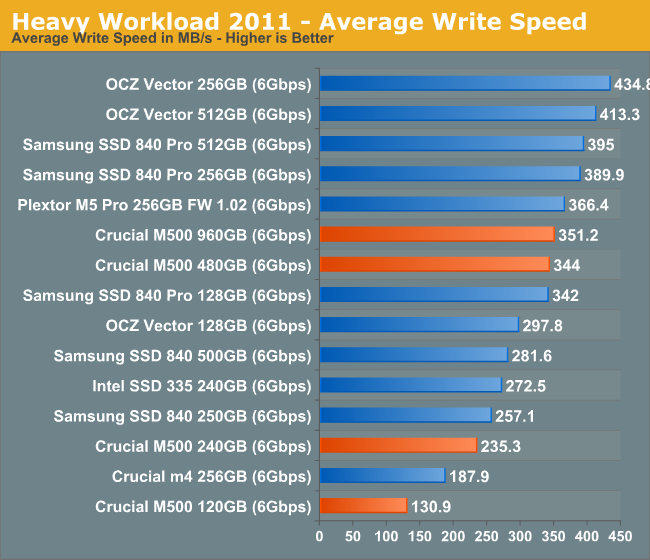
The next three charts just represent the same data, but in a different manner. Instead of looking at average data rate, we're looking at how long the disk was busy for during this entire test. Note that disk busy time excludes any and all idles, this is just how long the SSD was busy doing something:
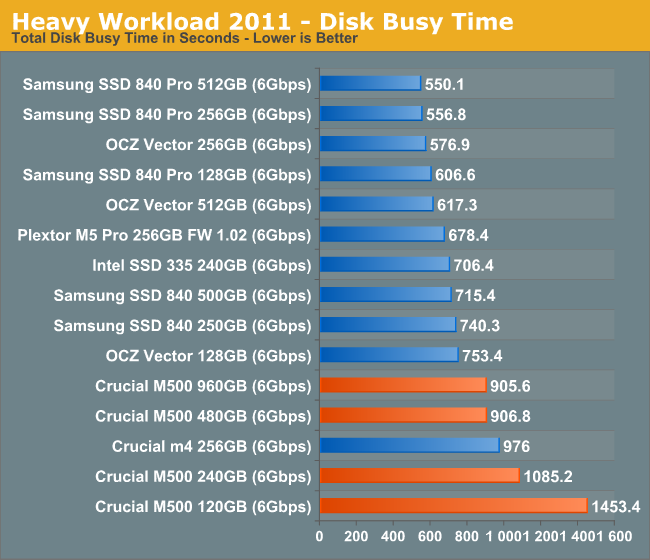
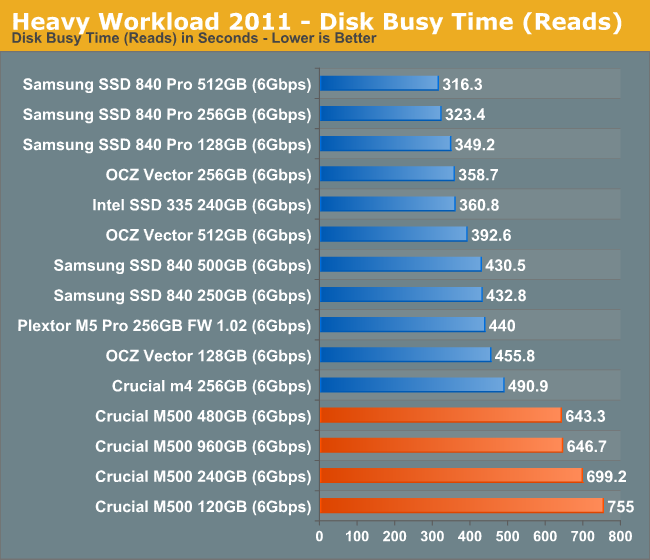
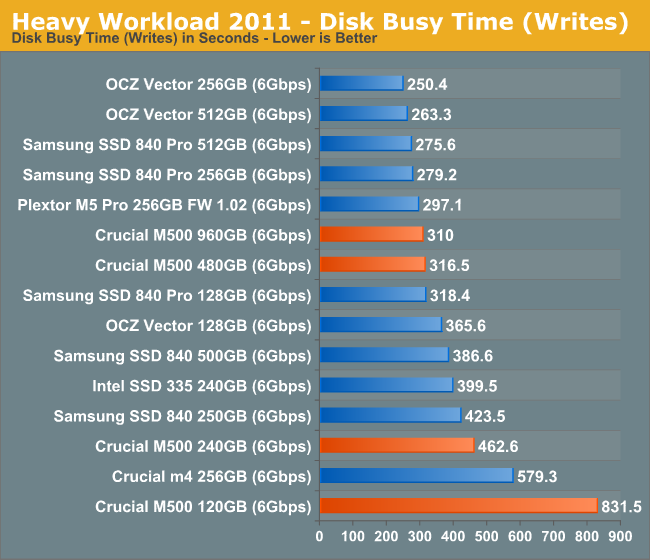










111 Comments
View All Comments
Bkord123 - Tuesday, April 9, 2013 - link
This might not be the place to ask this question, but here goes. I have a 4yr. old Macbook Pro and have wanted an SSD for years. BUT...I read a bunch of times that if you buy an aftermarket SSD instead of an SSD through Apple, you'll have issues with TRIM and that the only aftermarket SSDs that properly handle TRIM for Macs are the ones sold by OWC (MacSales.com). I really don't know much about this TRIM, but I got scared off because I was told the SSD performance will steadily decline which I do not want. Any help here, folks?!?lurker22 - Tuesday, April 9, 2013 - link
Yes just buy a non-OCZ drive and you'll be fine. all modern SSDs have garbage collection built in at hardware level, and there are several software "TRIM Enablers" you can get for OS X that work great. Stop worrying and just go buy one...lightsout565 - Tuesday, April 9, 2013 - link
lurker22 is correct. I recently bought a 128gb Samsung 830 to replace the decrepitly old 5400 drive in my late 2011 macbook pro 13". Install was a breeze. Just search "Trim Enabler" and install it. This allows you to enable TRIM on non-Apple SSD's. I've had it for about 3 weeks now and have had no problems. Once you go SSD, you don't go back. The speed is just incredible.Bkord123 - Tuesday, April 9, 2013 - link
Thanks to both lurker and lightsout! Now the question is, WHICH SSD??? I only need 240-256gb.damianrobertjones - Tuesday, April 9, 2013 - link
Go for the Samsung 840 Projamyryals - Tuesday, April 9, 2013 - link
Unless you have a specific need for the Pro versions of drives, I would get a Samsung 840. I have the 830, and it's excellent for my use (I'm a software dev). The speed differences between 840 and 840 Pro will not be noticeable for a "normal" workload. You'd be happy with either, but considering you most likely won't be able to tell the difference I'd just save the money and not get the pro.Andhaka - Friday, April 12, 2013 - link
Problem is the 840 standard has some issues on longevity using three layered cells. ;) Better invest in a 840 pro to gain some longevity to reuse the drive in a future computer.Cheers
Solid State Brain - Saturday, April 13, 2013 - link
Source?emperius - Saturday, July 6, 2013 - link
http://www.ubergizmo.com/2013/05/samsung-840-pro-r...ABR - Tuesday, April 9, 2013 - link
I had an OWC with 7% spare area in mine for a couple of years, never enabled TRIM (only available a third-party hack), did tons of writing and rewriting of mixed compressible and incompressible data daily, and ran the thing continually at 80-90% full -- and could observe no degradation in performance at all. Clearly some usage patterns can expose degradation, but it might not be as easy as it looks, or maybe just not as noticeable.